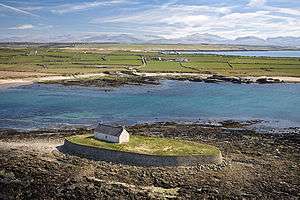Cribinau
|
Cribinau and St Cwyfan's church from the air | |
 Cribinau | |
| Geography | |
|---|---|
| Coordinates | 53°11′06″N 4°29′35″W / 53.185°N 4.493°W |
| Adjacent bodies of water | Caernarfon Bay |
| Administration | |
| Lieutenancy | Gwynedd |
| Unitary authority | Isle of Anglesey County Council |
| Community | Aberffraw |
| Additional information | |
| Ordnance Survey National Grid reference SH336682 | |
Cribinau is a small tidal island off the south west coast of the isle of Anglesey in Wales between Porth China and Porth Cwyfan. The island is in Aberffraw Community, about 1.2 miles (2 km) west of Aberffraw village.
The island can be reached on foot at low tide. It is notable for the 13th-century Church in Wales church of St Cwyfan, called in Welsh: eglwys bach y mor ("the little church in the sea") or simply Cwyfan.
Church
St Cwyfan's church was in existence by 1254 and was enlarged in the 14th and 15th centuries.[1] The building later fell into disrepair, and in the 19th century parts of the church were demolished.[1] By 1891 the surviving part was roofless, so an appeal was launched which paid for the building of a new roof.[1] In about the 1970s all the windows were restored, but now the building is deteriorating again and a new restoration appeal has been launched.[1]
Sea erosion
A Jacobean map dated 1636 shows the church standing on the mainland of Anglesey.[2] Written evidence submitted in 1770 in the case against Dr Thomas Bowles (see below) says that the road from Aberffraw to Llangwyfan was bad, but makes no mention of the tide restricting access to the church.[3] Therefore, it seems to be after that date that sea erosion of the boulder clay cliffs turned Cribinau into an island. By the 19th century, erosion was causing graves in the churchyard to fall into the sea, so a seawall was built around the island to protect the remaining graves and the church.[1]
Welsh language controversy

By 1766 St Cwyfan, Llangwyfan was a chapelry of the parish of St Beuno, Trefdraeth.[3] In that year John Egerton, Bishop of Bangor, appointed an elderly English priest, Dr Thomas Bowles, to the parish and chapelry.[3][4] Between them the parish and chapelry had about 500 parishioners, of whom all but five spoke only Welsh, whereas Bowles spoke only English.[3][4]
The parishioners and churchwardens of Trefdraeth petitioned against Bowles' appointment, with the Honourable Society of Cymmrodorion supporting and helping to fund their case.[3][4] The Court of Arches heard evidence in the case in May 1770 but did not hear the prosecution and defence arguments until January 1773.[3][4]
The prosecution argued that Bowles' inability to minister in Welsh contravened Article XXV of the Articles of Religion, the Act for the Translation of the Scriptures into Welsh 1563 and the Act of Uniformity 1662.[3] The defence argued that the prosecution would have to prove that Bowles was totally incapable of speaking any Welsh at all, and even if they did so Bowles had lawfully been granted the ecclesiastical freehold and therefore could not be deprived of it.[3]
The case was judged by Dean of Arches, George Hay.[3] In January 1773 he ruled that only clergy who could speak Welsh should be appointed to Welsh-speaking parishes, and Bowles should not have been appointed, but he now held the ecclesiastical freehold of the benefice and the case to deprive him of it had not been proved.[3] He therefore let Bowles stay in post, which he did until he died in November of that year.[3] Bowles was then replaced in the parish and chapelry with Richard Griffith, a priest who spoke Welsh.[3]
Current use
The church remains in use and is popular for weddings and baptisms.
References
- 1 2 3 4 5 "Local Landmarks and Places of Interest". Aberffraw. Aberffraw School. Retrieved 17 June 2013.
- ↑ "Anglesey Antiently called Mona. Described 1620". Anglesey History. Warren Kovach. 2012. Retrieved 17 June 2013.
- 1 2 3 4 5 6 7 8 9 10 11 12 The Cymmrodorion (1773). The Depositions, Arguments and Judgement in the Cause of the Church-Wardens of Trefdraeth, In the County of Anglesea, against Dr. Bowles; adjudged by the Worshipful G. Hay, L.L.D. Dean of the Arches: Instituted To Remedy the Grievance of preferring Persons Unacquainted with the British Language, to Livings in Wales. London: William Harris. Retrieved 18 June 2013.
- 1 2 3 4 Ellis, Peter Berresford (1994) [1993]. Celt and Saxon The Struggle for Britain AD 410–937. London: Constable & Co. pp. 241–242. ISBN 0-09-473260-4.
External links
- Roberts, Dave (13 April 2013). "Aberffraw to Porth Cwyfan – Easy Walk on the Anglesey Coastal Path". Mud and Routes.
